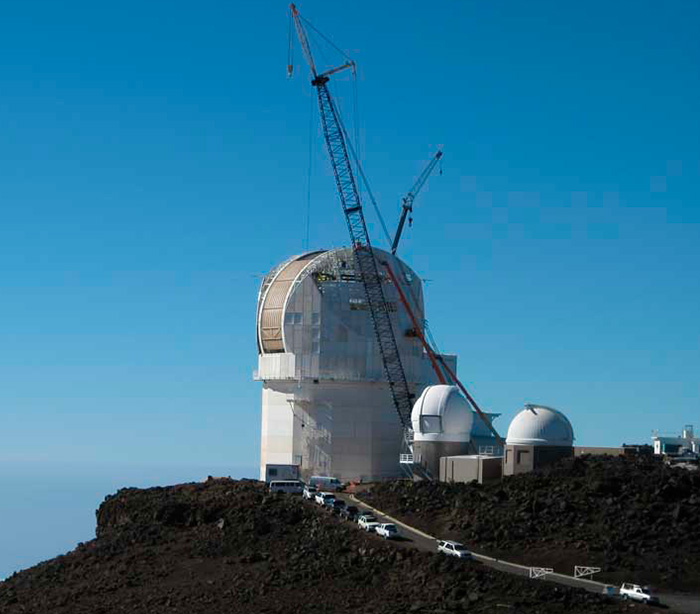The equipment meets the specs and timetable required for critical thermal-control functions.
Griswold
12/22/2016
 Image 1. The Daniel K. Inouye Solar Telescope (DKIST) under construction on the Haleakalā volcano summit in Maui, Hawaii, will provide the sharpest views ever taken of the sun’s surface but requires precise thermal control of its dome exterior. (Courtesy of DKIST)
Image 1. The Daniel K. Inouye Solar Telescope (DKIST) under construction on the Haleakalā volcano summit in Maui, Hawaii, will provide the sharpest views ever taken of the sun’s surface but requires precise thermal control of its dome exterior. (Courtesy of DKIST).jpg) Image 2. The DKIST will study solar phenomena such as these superheated plasma loops in much greater resolution than possible with current installations. (Courtesy of NASA SDO Instrument Teams)
Image 2. The DKIST will study solar phenomena such as these superheated plasma loops in much greater resolution than possible with current installations. (Courtesy of NASA SDO Instrument Teams)The DKIST
To provide solar scientists with a telescope capable of observing the sun at the required high resolution, a collaboration of 22 institutions—headed by the NSO, NSF and AURA—worked together to build the world’s largest solar telescope. The $344 million DKIST will allow observations with unprecedented spatial, spectral and temporal resolution using sub-second spectroscopic and magnetic measurements of the solar photosphere, chromosphere and corona. Its location on Haleakalā was selected for its reliable, clear daytime atmospheric viewing conditions. Construction at the DKIST site began in January 2013, and full operational capability is scheduled for 2020.Controlling Surface Temperature
When telescopes operate with such high resolution, all factors affecting performance must be managed to ensure maximum equipment accuracy. This means that all observatory and telescope thermal surface environments must be controlled, a task that is overseen by LeEllen Phelps, NSO thermal systems manager. Phelps manages the design, equipment acquisition and construction of all facility thermal systems at the DKIST. “It is critical that we control the thermal environment of every optic, every instrument and every path that the optical train passes through,” Phelps said. “To do this at the required precision, we must install numerous thermal-management systems throughout the structure. Our goal is to maintain the instruments and facility at a uniform temperature matching that of the ambient air within ±2 C (±3.6 F). Only so much of that degradation can be compensated for in the optics of the telescope.” The exterior surface of the telescope enclosure is one important thermal environment that must be controlled. The dome presents more than a quarter-acre of surface area, and its temperature must be precisely regulated to closely match the ambient air. Any temperature differentials between the ambient air and the building surfaces create what scientists call “seeing,” which is a density differential in the air that degrades the optical path and results in image distortion. According to Phelps, the pumps are the heart of the coolant-distribution system that manages the thermal environment of the observatory exterior. “We will use pumps to circulate 10 different temperatures of closed-loop heat-transfer fluid to cool different components of the observatory, including the exterior, to a very precise temperature that follows whatever the ambient temperature happens to be at a given time,” Phelps said. “Several closed loops will circulate coolant a few degrees below the ambient temperature to keep the exterior skin temperature at a state constantly matching ambient conditions, even with the sun hitting the surface and with varying wind conditions.” Pumps used for this purpose must meet strict specifications. “In this application, we are using an ionic brine for the heat-transfer solution in a regime of low temperatures that are much lower than what conventional HVAC pumps could handle without freezing up and having issues,” Phelps said. “It’s mostly the low temperatures ... in some of the cooling regimes that determined the most important pump specification parameters. Energy efficiency was also an important factor because of the high cost of power on Maui.”.jpg) Image 3. LeEllen Phelps, NSO thermal systems manager, signals that the pumps passed all required factory-acceptance tests. (Courtesy of Griswold Pump Company, part of PSG, a Dover Company)
Image 3. LeEllen Phelps, NSO thermal systems manager, signals that the pumps passed all required factory-acceptance tests. (Courtesy of Griswold Pump Company, part of PSG, a Dover Company)High-Performance Pumps
From the onset, the NSO set an aggressive construction schedule—and thermal-system component selection and acquisition were no exception. After a competitive-bid process, the pump contract was awarded to James, Cooke & Hobson Inc. (JCH), a major industrial equipment distributor based in Albuquerque, New Mexico, with offices in Arizona, Texas, California and Nevada. JCH Sales Engineer Dean Newbold was lead on the project and knew immediately that meeting the aggressive deadlines set by the NSO would be a challenge. “This was not a small project because there were 26 pumps, motors and baseplates needed,” Newbold said. The pump manufacturer worked closely with Newbold to meet the deadlines by building, testing and delivering 26 American National Standards Institute (ANSI) centrifugal pumps in nine different sizes and configurations, including some with a low-flow configuration. NSO staff monitored pump testing to measure suction pressure (pounds per square inch [psi]), discharge pressure (psi), power (horsepower [hp]), speed (revolutions per minute [rpm]), flow (gallons per minute [gpm]), fluid temperature (F) and vibration. Exceeding standard ANSI construction requirements, the selected pumps offer design innovations that deliver long-term operational reliability:- a fully open impeller with rear adjustment capability and twice the wear area of enclosed models for superior handling of solids, corrosives and abrasives
- back pump-out vanes that reduce hydraulic loads and seal-chamber pressure, resulting in smooth, stress-free operation
- standard bronze labyrinth oil seals that keep outside contaminants from entering the lubrication media, which extends bearing life
- extra-heavy casings that incorporate a standard Class 300 wall thickness that extends casing life even when used with severely corrosive or erosive fluids
- heavy-duty shaft that minimizes vibration and shaft deflection, resulting in optimized pump life, and bearings that are sized for a 10-year life span

